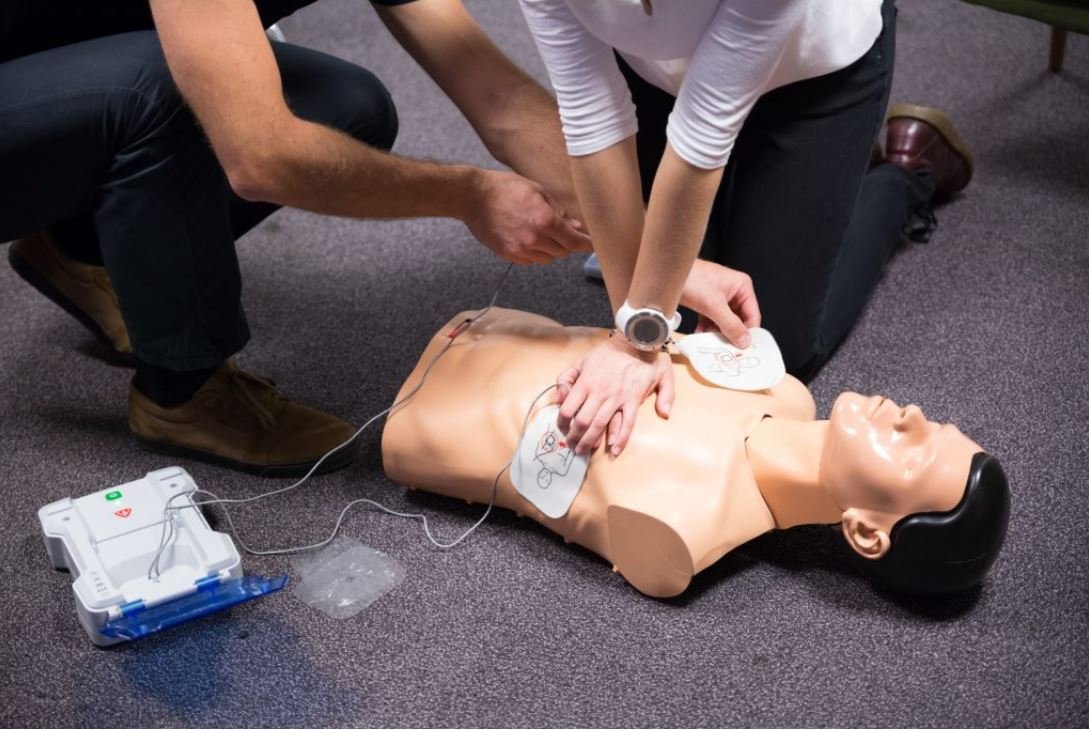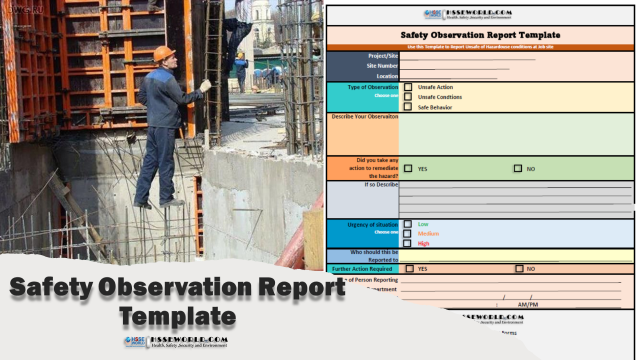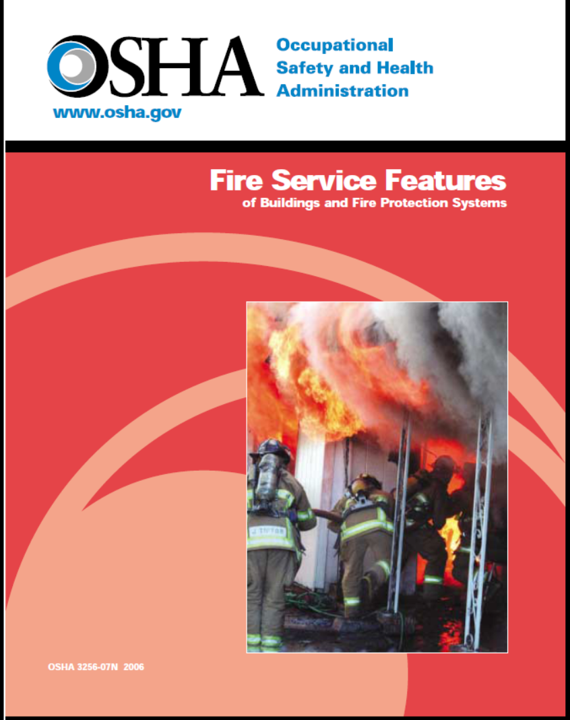
Fire Service Features of Buildings and Fire Protection Systems is a manual that provides a general overview of a particular topic related to OSHA standards concerning
fire and emergency protection. The manual is advisory in nature and informational in content. It is not a standard or a regulation, and it neither creates new legal obligations nor alters existing obligations created by OSHA standards or the Occupational Safety and Health Act.
Employers are required to comply with hazard-specific safety and health standards as issued and enforced either by the Occupational Safety and Health Administration (OSHA) or by an OSHA approved
State Plan. In addition, Section 5(a)(1) of the Occupational Safety and Health Act, the General Duty Clause, requires employers to provide their employees with a workplace free from recognized hazards likely to cause death or serious physical harm. Employers can be cited for violating the General Duty Clause if there is such a recognized hazard, and they do not take reasonable steps to prevent or abate the hazard. However, the failure to implement any of the recommendations in this manual is not, in itself, a violation of the General Duty Clause. Citations can only be based on standards, regulations, and the General Duty Clause.
This manual does not supersede or substitute for any local or state laws, codes, ordinances, regulations, or amendments thereto. This manual shall only be used as a nonbinding supplement to a jurisdiction’s requirements.
Also Read: High Rise Fire Safety Questions and Answers
Snaps of the Book
PURPOSE
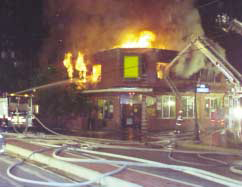
The purpose of this manual is to increase the safety of building occupants and emergency responders by streamlining fire service interaction with building features and fire protection systems. The information in this manual will assist designers of buildings and fire protection systems to better understand the needs of the fire service when they are called upon to operate in or near the built environment (figure 1.1). To put this another way, architects and engineers create workplaces for firefighters.
Designs can be tailored to better meet operational needs, thereby reducing the time it takes to mitigate an incident.
Also Read: E-Books: Electrical Safety Code Manual
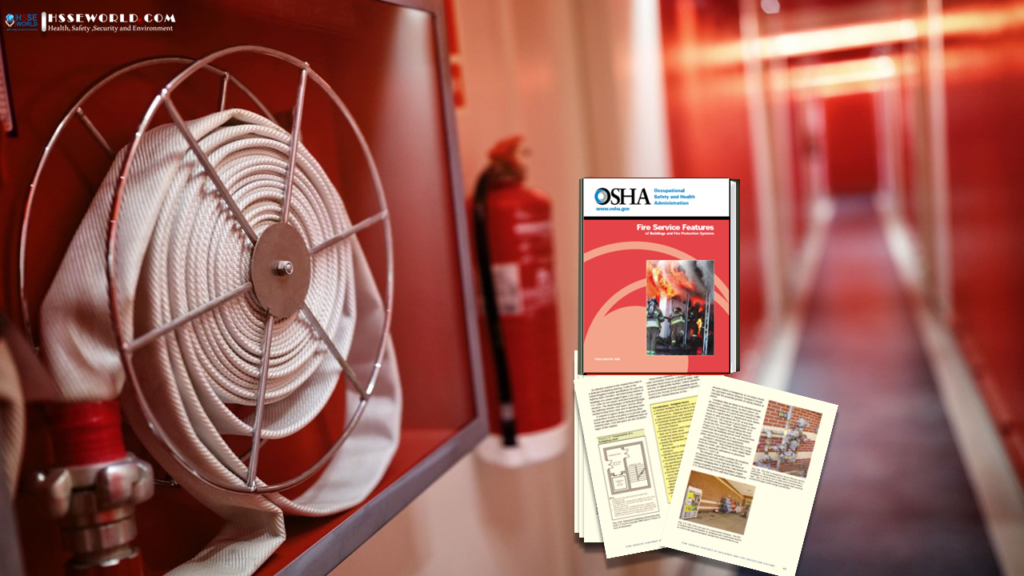
The guidance in this manual is expected to decrease the injuries to responding and operating fire service personnel. When an incident can be mitigated faster, there is less time for the hazardous situation to grow in proportion. With less potential exposure, employees occupying buildings will be afforded greater protection from fire incidents.
Employee occupants as well as fire service employees will realize the benefits of this manual in terms of safe working conditions as intended by the Occupational Safety and Health Act of 1970.
The codes and standards governing buildings and fire protection systems are well understood by designers. However, many portions of these codes and standards allow design variations or contain only general performance language. The resulting flexibility permits the selection of different design options. Some of these options may facilitate fire service operations better than others.
The particular needs and requirements of the fire service are typically not known thoroughly by persons not associated with these operations. This manual discusses how the fire service interacts with different building features and it suggests methods for streamlining such interaction. To provide the most effective protection, fire service personnel should be considered as users of building features and fire protection systems. While far less frequent than mechanical events or other failures, fire can cause greater destruction in terms of property loss, disruption of operations, injury, and death.
Also Read: Photo of the day: Fire Emergency
Designers routinely consider the needs and comfort of building occupants when arranging a building’s layout and systems. Within the framework of codes and standards, design options may be exercised to benefit a particular owner, tenant, or user. For example, a building code would typically dictate the minimum number of lavatories and water fountains. However, the location, distribution, and types of such facilities are left to the designer in consultation with the client.
SCOPE
This manual is to be used voluntarily, as a companion to mandatory and advisory provisions in building codes, life safety codes, fire codes, safety regulations, and installation standards for fire protection systems. The material contained in this document focuses on ways that building and fire protection system designers can contribute to the efficiency of fire suppression operations.
This material is applicable to all fire service organizations, including fire brigades and fire departments. Many of the considerations in the following chapters will also help during responses to other emergencies, such as hazardous materials releases, emergency medical care, non-fire rescues, and terrorist events.
Also Read: E-Books: Evaluation of Fire Safety free download
Contents
The content of the Fire Service Features of Buildings and Fire Protection Systems
- Chapter 1-Introduction
- Chapter 2-Building and Site Design
- Chapter 3-Sprinkler Systems
- Chapter 4-Standpipe Systems
- Chapter 5-Fire Department Connections
- Chapter 6-Fire Alarm and Communication Systems
- Chapter 7-Other Systems
- Appendix
Also Read: Workplace Fire Safety Program
You can Download Other safety Resources at https://safetybagresources.com/
Download the book
E-Books: Fire Service Features of Buildings and Fire Protection Systems
More Downloads
- E-Books: Healthcare Hazard Control & Safety Management
- E-Books: Safety, Health and Working Conditions Training Manual
- E-Books: Energy Efficiency in Water and Wastewater Facilities
- E-Books: Fire Service Features of Buildings and Fire Protection Systems
- E-Books: Evaluation of Fire Safety free download
- E-Books: PPE for Chemical, Biological, and Radiological Hazards free
- E-Books: Changing the Workplace Safety Culture free download
- E-Books: Site Emergency Planning Workbook
- E-Books: Load Restraint Guide
- E-Books: Essential Practices for Creating, Strengthening, and Sustaining Process Safety Culture
- E-Books: System Safety Engineering and Risk Assessment
- E-Books: Permit-Required Confined Spaces
- E-Books: Is it Safe to Enter Confined Space?
- E-Books: 5-Minute Workplace Safety Talks
- E-Books: Safety Culture and High-Risk Environments
- E-Books: Practical Guide to Industrial Safety
- E-Books: Slip, Trip, and Fall Prevention for Healthcare Workers
- E-Books: Health and Safety at Work Key Terms
- E-Books: Fundamentals of Process Safety Engineering
- E-Books: Gas Detection Hand Book
- E-Books: Occupational health and safety management systems ANSI-AIHA-z10-2012
- E-Books: Hot Work on Drums and Tanks
- E-Books: Human Fatigue Risk Management
- E-Books: Guidelines for the provision of facilities and general safety in the construction industry
- E-Books: Handbook of Training in Mine Rescue and Recovery Operations ( 2021)
- E-Books: Code of Practice for the Safe Use of Lifting Equipment – Edition 9 (Nov 2019)
- E-Books: Free Forklift Health and Safety Best Practices Guideline
- E-Books: Handbook of Hazardous Chemical Properties
- E-Books: Human Performance Improvement through Human Error Prevention
- E-Books: Principles Of Fire Risk Assessment In Buildings
- E-Books: Investigation of Occupational Accidents and Diseases
- E-Books: Radiation Protection and Safety in Industrial Radiography
- E-Books: Basic Guide to System Safety, Third Edition
- E-Books: Food Safety Management-A Practical Guide for the Food Industry
- E-Books: Safety identification: Escape and evacuation plan signs- ISO 23601
- E-Books: Safety at Work
- E-Books: The Safety-Critical Systems Handbook 4th edition
- E-Books: Fundamental principles of occupational health and safety
- E-Books: Fire Safety Risk assessment Guide – Sleeping Accommodation
- E-Books: Mental health at work series
- E-Books: Live Fire Training: Principles and Practice
- E-Books: Pre-Startup Safety Review Guide
- E-Books: Fire and Emergency Drill Manual and Building Inspection Guide
- E-Books: Health and Safety: Risk Management 5th edition
- E-Books: Fire Protection systems -Third edition 2021
- E-Books: Fire Safety Logbook templates
- E-Books: From Accidents to Zero
- E-Books: Electric Safety Practice and Standards
- Your steps to chemical safety
- E-Books: Ergonomics and Psychology Developments in Theory and Practice
- E-Books: HAZOPS Should BE fun-The Stream-Based HAZOP
- E-Books: Safety Health and Environmental Auditing
- E-Books: A Quick Guide to Health and Safety
- E-Books: Occupational Ergonomics A Practical Approach
- E-Books: Job Hazard Analysis A Guide for Voluntary Compliance and Beyond
- E-Books: Electrical Safety of Low Voltage Systems



